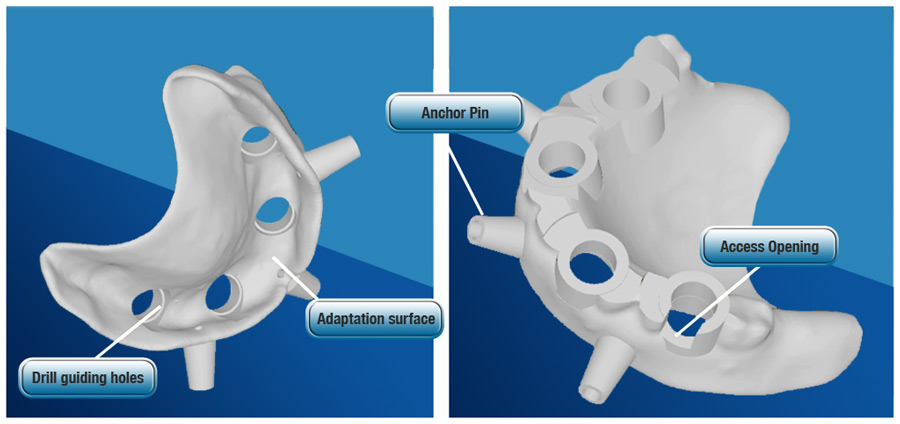Surgical Guides and Kit
Scan Implant Guide Surgical Guides
Surgical Guide Elements improve the accuracy and safety of implant placement so that the implants can be placed correctly for the best possible aesthetics and surgical outcome. As illustrated in Fig. 1, a surgical guide has the following basic elements:
- an adaption surface, that fits onto the patient’s anatomy
- drilling holes with sleeves inserted, which comply with the treatment plan and guide the actual drills; and
- optional form features like irrigation windows and holes for anchor screws and anchor pins.
Guide Fabrication Process
All Scan Implant Surgical Guides are produced using advanced digital manufacturing technologies. The surgical guides are generated by the Scan Implant Guide planning Software based upon the clinician’s virtual planning of the optimal location of the dental implants in the patient’s jaw bone. The software uses the dentist’s approved treatment plan to design and produce a customized surgical guide that simplifies the drilling process and guides the dentist to place the implant in the precise location as planned. Once designed, the guides are produced automatically, without any intervention by the technician, on our state-of-the-art 3D printer. They are manufactured out of a photopolymer resin approved for biomedical applications, and the titanium drill sleeves are manually inserted before the guide is shipped to the doctor non-sterile.
Guides for Most Implant Manufacturers.
The Scan Implant Guide Planning Software library includes the implants and surgical kits of most major implant manufacturers — and new implant manufacturers are being added all the time. So, regardless of which implant you prefer to use, Scan Implant Guide can produce a surgical guide precisely fabricated tothe implant manufacturer’s specifications.
Sterilization.
Before use, the surgical guide should be sterilized using a cold sterilization solution of ethylene oxide. Any cold sterilization solution should not contain more than 15% alcohol, and the guide should not be immersed in the solution for more than 30 minutes. After removal from the sterilization solution, the guide should still feel firm and rigid. If the guide feels soft after sterilization, it should not be used.
Samples of surgical guides.
Guided Surgery Kit
Scan Implant Guide’s surgical kit is designed and organized to make each instrument easily identifiable and placed within the easy reach of the clinician. The precision engineered handled drill guides are provided in a Standard Format for placing implants up to Ø4.2mm, and a Wide Format for placing implants up to Ø5.0mm. The 24 drill bits are in lengths of 17mm, 21mm, 25mm and 30mm, and in diameters from 2.0mm to 4.5mm. This allows the clinician to use guided surgery to place a very broad range of implant sizes. For those cases where flapless surgery is indicated, there is a tissue punch provided for both the Standard and Wide formats. And for cases involving totally (or mostly) edentulous patients, the kit includes fix pins and fix pin drills in two lengths to anchor the surgical guide to the patient’s anatomy. The box, itself is intuitively organized for maximum utility, is suitable for autoclave sterilization and – when fully opened – tilts the instrument tray up 30˚ for easy accessibility.
Guided Surgery Kit






